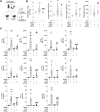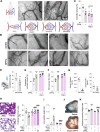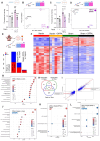DPP4 inhibition curbs systemic inflammation
- PMID: 40817204
- PMCID: PMC12357438
- DOI: 10.1186/s13054-025-05599-x
DPP4 inhibition curbs systemic inflammation
Abstract
Background: Systemic inflammation is a critical clinical condition regularly observed in the context of surgery-induced trauma or infection. Systemic inflammation induces an ubiquitous activation of the vasculature and vascular dysfunction related to organ damage and adverse outcomes. The dipeptidyl peptidase-4 (DPP4) modulates the receptor preferences and activity of a multitude of humoral substrates mediating the systemic inflammatory response. We here determined whether DPP4 inhibition is a means to beneficially modulate systemic inflammatory responses affecting vascular and organ integrity.
Methods: In cardiac surgery patients medicated with DPP4 inhibitors, we used a systems biology approach for in-depth characterization of the perioperative immune response and assessment of macro- and microvascular dynamics compared to control patients. In parallel, we mechanistically evaluated the efficacy of DPP4 inhibition on modulating immune responses, capillary leakage, vasoplegia and endothelial transcriptomic profiles in mice with severe systemic inflammation.
Results: Preoperative oral intake of the DPP4 inhibitor sitagliptin modulated innate and adaptive immune phenotypes and was associated with augmented microvascluar integrity, reduced vasoplegia and improved clinical parameters of capillary leakage in patients undergoing cardiac surgery. In mice, DPP4 inhibition curbed the inflammatory response to a polymicrobial sepsis resulting in a massive reduction in endothelial gene activation assoicated with preserved vascular barrier function, augmented vasopressor responses and organ integrity.
Conclusions: We conclude that DPP4 inhibition may be a safe and potent means to curb immune responses to surgery or infection, resulting in a preservation of vascular integrity that translates into organ protection and improved clinical outcomes.
Trial registration: https://www.
Clinicaltrials: gov ; Unique identifier: NCT05725798, study start: 2022-02-01.
Keywords: Capillary leakage; Cardiac surgery; DPP4 inhibitor; Inflammation; Vasculature.
© 2025. The Author(s).
Conflict of interest statement
Declarations. Ethics approval and consent to participate: The human study was approved by the Ethics Committee of the Medical Association Westphalia-Lippe (ÄKWL, ID: 2019-080-f-S) and registered to ClinicalTrials.gov (NCT05725798). Written informed consent was received prior to study participation. Animal experiments were approved by the governmental ethical board at the Animal Care and Use Committee of North Rhine Westphalia and Bavaria, Germany, AZ81-02.04.2018.A336 and RUF-55.2.2-2532-2-1822-16. Consent for publication: Not applicable. Competing interests: The authors declare no competing interests.
Figures





References
-
- Joffre J, Hellman J, Ince C, Ait-Oufella H. Endothelial responses in sepsis. Am J Respir Crit Care Med. 2020;202:361–70. 10.1164/rccm.201910-1911TR. - PubMed
-
- Miranda M, Balarini M, Caixeta D, Bouskela E. Microcirculatory dysfunction in sepsis: pathophysiology, clinical monitoring, and potential therapies. Am J Physiol Heart Circ Physiol. 2016;311:H24–35. 10.1152/ajpheart.00034.2016. - PubMed
-
- Vanhoof G, Goossens F, De Meester I, Hendriks D, Scharpé S. Proline motifs in peptides and their biological processing. FASEB J. 1995;9:736–44. - PubMed
Publication types
MeSH terms
Substances
Associated data
LinkOut - more resources
Full Text Sources
Medical
Miscellaneous

